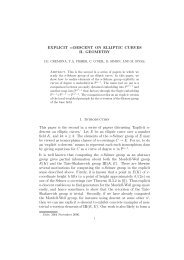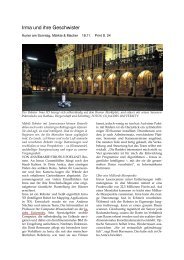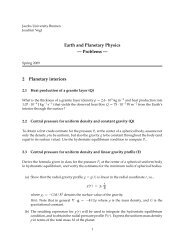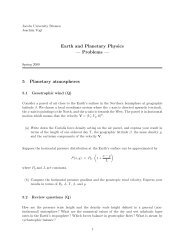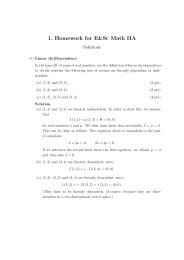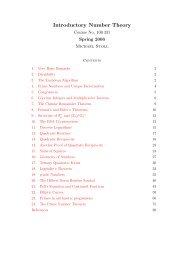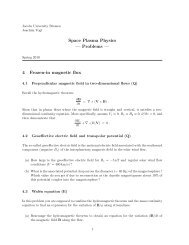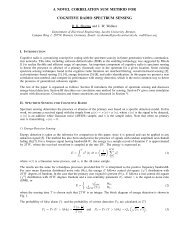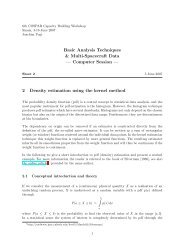Linear Algebra II (pdf, 500 kB)
Linear Algebra II (pdf, 500 kB)
Linear Algebra II (pdf, 500 kB)
You also want an ePaper? Increase the reach of your titles
YUMPU automatically turns print PDFs into web optimized ePapers that Google loves.
44<br />
If I is finite, say I = {1, 2, . . . , n}, then we also write<br />
V = V1 ⊕ V2 ⊕ · · · ⊕ Vn ;<br />
as a set, it is just the cartesian product V1 × · · · × Vn.<br />
11.2. Proposition. Let (Vi)i∈I be a family of F -vector spaces, and V = <br />
i∈I<br />
their direct sum.<br />
(1) There are injective linear maps ιj : Vj → V given by<br />
ιj(vj) = (0, . . . , 0, vj, 0, . . . ) with vj in the jth position<br />
such that with ˜ Vj = ιj(Vj), we have V = <br />
j∈I ˜ Vj as a direct sum of<br />
subspaces.<br />
(2) If Bj is a bais of Vj, then B = <br />
j∈I ιj(Bj) is a basis of V.<br />
(3) If W is another F -vector space, and φj : Vj → W are linear maps, then<br />
there is a unique linear map φ : V → W such that φj = φ ◦ ιj for all j ∈ I.<br />
Proof.<br />
(1) This is clear from the definitions, compare 4.1.<br />
(2) This is again clear from 4.1.<br />
(3) A linear map is uniquely determined by its values on a basis. Let B be a<br />
basis as in (2). The only way to get φj = φ ◦ ιj is to define φ(ιj(b)) = φj(b)<br />
for all b ∈ Bj; this gives a unique linear map φ : V → W .<br />
Statement (3) above is called the universal property of the direct sum. It is essentially<br />
the only thing we have to know about <br />
i∈I Vi; the explicit construction is<br />
not really relevant (except to show that such an object exists).<br />
12. The Tensor Product<br />
As direct sums allow us to “add” vector spaces in a way (which corresponds to<br />
“adding” their bases by taking the disjoint union), the tensor product allows us to<br />
“multiply” vector spaces (“multiplying” their bases by taking a cartesian product).<br />
The main purpose of the tensor product is to “linearize” multilinear maps.<br />
You may have heard of “tensors”. They are used in physics (there is, for example,<br />
the “stress tensor” or the “moment of inertia tensor”) and also in differential<br />
geometry (the “curvature tensor” or the “metric tensor”). Basically a tensor is<br />
an element of a tensor product (of vector spaces), like a vector is an element of<br />
a vector space. You have seen special cases of tensors already. To start with, a<br />
scalar (element of the base field F ) or a vector or a linear form are trivial examples<br />
of tensors. More interesting examples are given by linear maps, endomorphisms,<br />
bilinear forms and multilinear maps in general.<br />
The vector space of m × n matrices over F can be identified in a natural way with<br />
the tensor product (F n ) ∗ ⊗ F m . This identification corresponds to the interpretation<br />
of matrices as linear maps from F n to F m . The vector space of m×n matrices<br />
over F can also identified in a (different) natural way with (F m ) ∗ ⊗ (F n ) ∗ ; this<br />
corresponds to the interpretation of matrices as bilinear forms on F m × F n .<br />
In these examples, we see that (for example), the set of all bilinear forms has the<br />
structure of a vector space. The tensor product generalizes this. Given two vector



